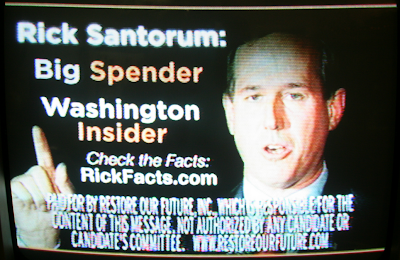
Bloomberg realiza una radiografía del gran protagonista de esta campaña, el Super PAC de Romney:
One of the political ads airing in the run-up to the April 3 Wisconsin primary accuses Rick Santorum of voting with former Senator Hillary Clinton in favor of granting voting rights to violent convicted felons.
Santorum’s campaign says the commercial is untrue, yet that hasn’t stopped Restore Our Future, a so-called super-political action committee supporting Mitt Romney, from running it and another attack ad more than 1,647 times on Wisconsin television stations, according to New York-based Kantar Media’s CMAG, a firm that tracks advertising.
The firepower, to which Santorum has yet to respond, fits a pattern that has become a defining feature of the 2012 Republican presidential primary race. Since the contests began, Restore Our Future has spent $35 million on commercials attacking Santorum, a former Pennsylvania U.S. senator, and Newt Gingrich, the former U.S. House speaker, the two candidates who have come closest to knocking Romney out of front-runner status, according to the Washington-based Center for Responsive Politics, which tracks political money. The super-PAC has spent just $1.1 million promoting Romney, the data shows.
“They need to demonize and destroy, they need to slash and burn their opponents,” said David Johnson, a Republican strategist from Atlanta who worked on former Senator Bob Dole’s Republican presidential bid in 1988 and is unaffiliated with any candidate this cycle. “That’s the only way Romney can win” because he has “no base of support,” he said.
(...) John Brabender, a Santorum senior adviser, called the ads “troubling,” particularly since they are aimed at Republicans. “Why in the world didn’t he spend his $35 million running ads against Obama instead of brutally attacking Republicans?” Brabender said.
Romney’s campaign has run fewer positive ads to promote his candidacy than Restore had spent on negative commercials aimed at his top rivals. The campaign has aired 12,817 spots, almost all of them positive, since January of 2011, according to CMAG. The commercial run most often is called “Moral Responsibility,” which touts Romney’s commitment to be a strong financial steward for the nation.
In Wisconsin, and elsewhere, the campaign ads illustrate the role that super-PACs are playing in presidential elections after the Supreme Court ruled in 2010 that independent third parties have a constitutional right to raise and spend as much as they want on political ads.
In the case of Santorum and Gingrich, wealthy donors to their friendly super-PACS, called respectively the Red, White and Blue Fund and Winning Our Future, have helped keep them in the race when their own fundraising faltered. Restore Our Future has helped Romney by ensuring neither of those candidacies gain momentum.
The only court stipulation is that the groups can’t coordinate their activities with a campaign. Candidates found a way around that hurdle by dispatching aides to operate them. Restore is run by former Romney advisers, including Charles R. Spies, who was Romney’s general counsel in the 2008 Republican primary. Its board of directors includes Carl Forti, who was political director four years ago.
“The way they function is essentially a parallel presidential campaign,” said Anthony Corrado, a political scientist at Colby College in Waterville, Maine. “The notion that these PACs are independent is nothing more than a legal technicality.”
The pro-Romney group’s leading contributor last month was Houston homebuilder Bob Perry, according to Federal Election Commission records. Perry helped fund the Swift Boat Veterans for Truth ads that attacked Democratic presidential nominee John Kerry’s Vietnam War service in the 2004 race. Restore’s ads are being made by Larry McCarthy, who in 1988 produced the “Willie Horton” ad that linked a murderer to Democratic nominee Michael Dukakis, a former Massachusetts governor, a smear even Republicans said was unfair.
Since Jan. 1 of last year, Restore has aired the same 16 negative ads 41,612 times in the major media markets of primary states from Michigan to Florida and Colorado, according to data provided by CMAG.
The committees backing Gingrich and Santorum ran 8,172 and 8,121 negative spots, respectively, according to data from CMAG.
Restore concentrated its firepower first on Gingrich in Florida after his Jan. 21 victory in South Carolina and then on Santorum in Ohio after his wins in Colorado and Minnesota on Feb. 7.
Its charge that Santorum supported giving convicted felons voting rights was repeated 2,671 times in two separate ads before the Ohio March 6 primary.
(...) A CMAG analysis as of March 7 found one of the anti- Santorum ads, titled “Values,” has aired a total of 4,650 times, making it the fourth-most-run spot of the campaign season, including those in support of President Barack Obama.
(...) In all, Restore ran 3,313 ads in the 10 days before Ohio’s March 6 vote, compared to 722 by the pro-Santorum PAC. Santorum lost narrowly to Romney, by four-fifths of a percentage point.
“He did the same thing in Michigan and Mississippi and every place,” said Brabender. “In Gingrich’s case, he did basically knock him out of the race.”
After his South Carolina win, Gingrich went into Florida’s Jan. 31 race in a dead heat with Romney, according to a Quinnipiac University poll conducted Jan. 19 to 23. In the final days before the primary, Restore ran five different ads in the state’s major media markets, every one of them attacking Gingrich and rated as negative by Kantar.
“Overnight a storm rained dollars on the television,” said Susan MacManus, a University of South Florida political scientist. “They had a big impact.”
No hay comentarios:
Publicar un comentario